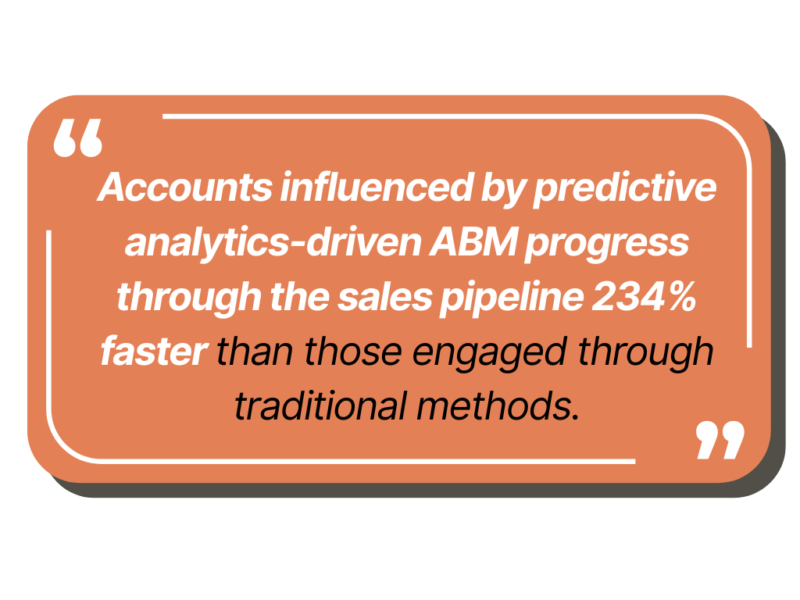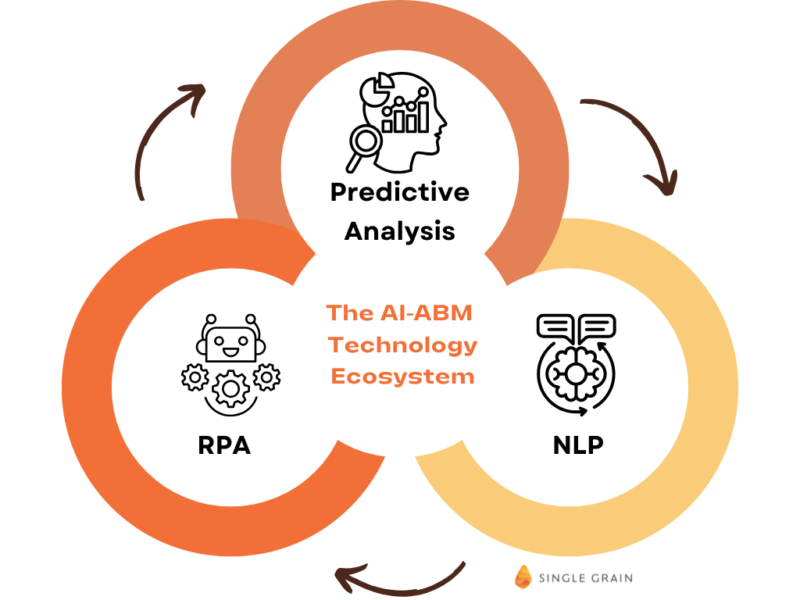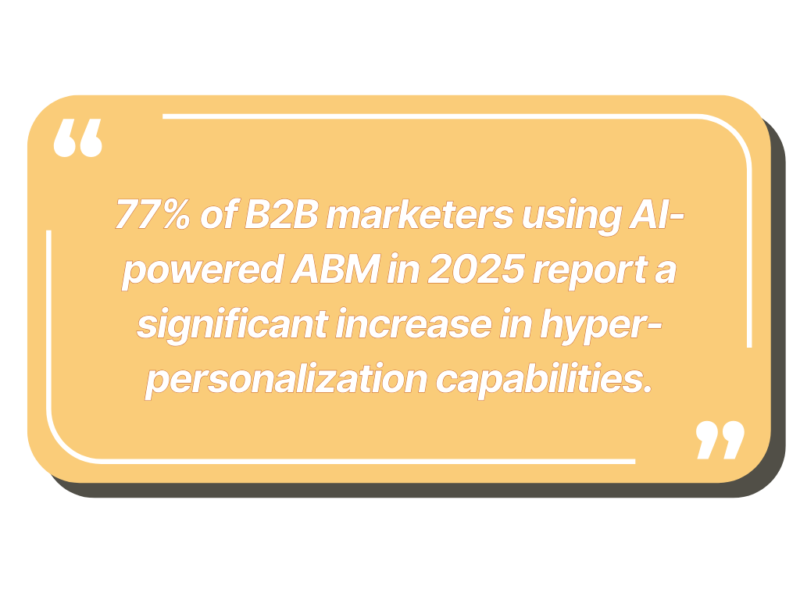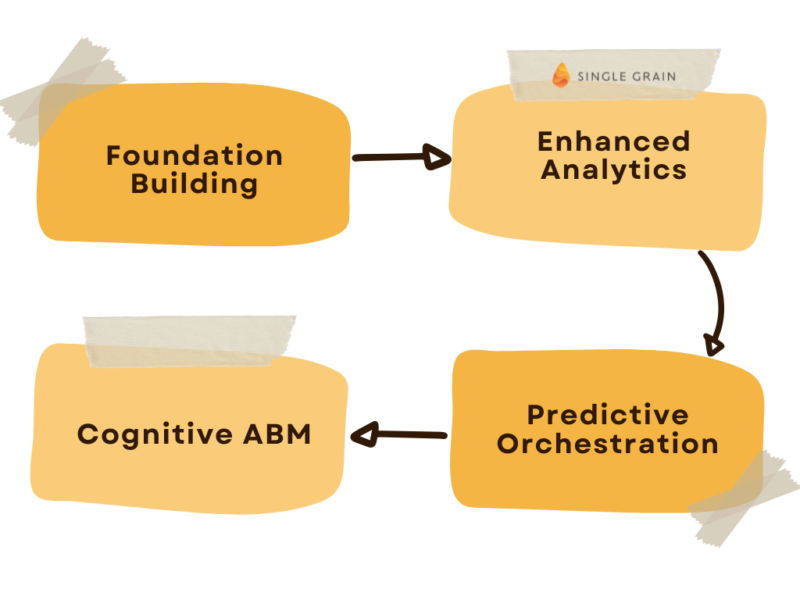AI-Powered ABM: Scale Personalization to 10,000+ Accounts
The traditional approach to Account-Based Marketing (ABM) has hit a wall. Marketers are expected to deliver highly personalized experiences to hundreds—even thousands—of target accounts while maintaining efficiency and proving ROI. It’s a seemingly impossible task until you add artificial intelligence to the equation.
According to recent data from Revnew, 87% of marketers report higher ROI from ABM strategies, with an impressive 208% growth in revenue attributed to ABM in 2025. But these results aren’t coming from traditional ABM tactics—they’re being driven by the integration of advanced AI technologies that fundamentally transform how marketing teams engage high-value accounts.
Key Takeaways
- AI-powered ABM delivers dramatically higher ROI with 87% of marketers reporting better results and a projected 208% growth in revenue attributed to ABM in 2025, far outperforming traditional account-based approaches.
- Three core AI technologies transform ABM effectiveness: predictive analytics identifies conversion-ready accounts, natural language processing enables content personalization at scale, and robotic process automation eliminates manual tasks.
- Personalization can be scaled without sacrificing quality through AI’s ability to analyze vast amounts of account data, segment dynamically, and continuously refine approaches based on engagement data.
- Sales pipelines accelerate significantly with AI-powered ABM driving 234% faster pipeline velocity and 25-40% higher conversion rates by identifying and acting on intent signals earlier.
- Implementation follows a four-stage maturity model from foundation building with basic automation to cognitive ABM with self-optimizing systems that continuously learn and adapt to maximize results.
TABLE OF CONTENTS:
What Is AI-Powered ABM and Why It Matters Now
AI-powered ABM represents the convergence of account-based strategies with artificial intelligence technologies like machine learning, natural language processing, and predictive analytics. Unlike conventional ABM, which often relies on manual segmentation and static campaigns, AI-driven approaches use real-time data analysis to identify patterns, predict behaviors, and personalize content at an unprecedented scale.
The difference is transformative. While traditional ABM might effectively target dozens of accounts with personalized messaging, AI-powered ABM delivers hyper-relevant experiences to thousands of accounts simultaneously without sacrificing quality or burning out your team.
“AI doesn’t replace the human element in ABM—it amplifies it. By automating data analysis and routine tasks, AI frees marketing teams to focus on strategy and creative development while ensuring every account interaction is informed by deep, actionable insights.”
Core AI Technologies Revolutionizing ABM
Three primary technologies are driving the AI-powered ABM revolution, each addressing specific challenges in the account-based approach:
Predictive Analytics: Identifying Tomorrow’s Opportunities Today
Predictive analytics uses historical data and machine learning to forecast which accounts are most likely to convert, what their needs will be, and when they’ll be ready to purchase. This capability eliminates much of the guesswork in account selection and prioritization.
RollWorks reports that accounts influenced by predictive analytics-driven ABM progress through the sales pipeline 234% faster than those engaged through traditional methods. This dramatic acceleration occurs because AI can identify buying signals before they become obvious, allowing marketing teams to engage prospects at precisely the right moment with precisely the right message.

Natural Language Processing (NLP): Content Personalization at Scale
NLP technologies analyze and generate human language, making it possible to create personalized content for thousands of accounts without expanding your creative team. Advanced NLP tools can:
- Analyze account communications to identify preferences and pain points
- Generate tailored messaging that resonates with specific roles and industries
- Customize content dynamically based on engagement patterns
- Maintain brand voice consistency across all communications
Robotic Process Automation (RPA): Eliminating Manual Tasks
RPA automates repetitive, rule-based tasks that would otherwise consume valuable marketing resources. In ABM, this might include:
- Updating CRM records with engagement data
- Scheduling follow-up communications based on account actions
- Routing leads to appropriate team members
- Generating performance reports
A Leading US-based SaaS Company implemented an AI-powered ABM platform that combined NLP for content personalization with RPA to automate campaign tasks. The result? A 40% reduction in campaign execution time and a 37% increase in engagement rates with target accounts.

Scaling Personalization: Solving the Quantity-Quality Paradox
Perhaps the most significant advantage of AI-powered ABM is its ability to deliver highly personalized experiences to thousands of accounts simultaneously—something that would be impossible with traditional approaches.
According to Smarketers, 77% of B2B marketers using AI-powered ABM in 2025 report a significant increase in hyper-personalization capabilities. This isn’t just about addressing emails with the recipient’s first name—it’s about tailoring entire campaign experiences based on industry-specific challenges, company size, current technology stack, and even the prospect’s role in the buying process.

The key to this level of personalization at scale lies in AI’s ability to:
- Analyze vast amounts of account data to identify meaningful patterns
- Segment accounts based on multiple dynamic factors
- Generate or modify content to address specific account characteristics
- Continuously learn from engagement data to refine personalization approaches
Want to take your personalization efforts to the next level? Personalize your ads and landing pages for more conversions with AI-driven tools that dynamically adjust messaging based on real-time engagement data.
Accelerating the Sales Pipeline with Predictive Intent
One of the most compelling benefits of AI-powered ABM is its ability to dramatically accelerate the sales cycle. By identifying and acting on intent signals earlier, marketing teams can engage accounts precisely when they’re most receptive to specific messages.
| Pipeline Metric | Traditional ABM | AI-Powered ABM | Improvement |
|---|---|---|---|
| Pipeline Velocity | Standard | 234% faster | +134% |
| Deal Identification | Reactive | Proactive/Predictive | Months earlier |
| Conversion Rate | Industry average | 25-40% higher | Significant increase |
| Sales Cycle Length | Standard | Reduced by weeks | Faster closures |
A Leading Software Company deployed an AI-powered ABM platform leveraging predictive analytics to tailor messaging and prioritize high-value accounts. The results speak for themselves: a 40% increase in pipeline velocity and a 25% improvement in close rates within just six months of implementation.
Strategic Implementation: The Four-Stage AI-ABM Maturity Model
Successfully implementing AI-powered ABM isn’t about flipping a switch—it’s a progressive journey that typically follows a four-stage maturity model:
Stage 1: Foundation Building
Begin with basic automation and data integration. Key activities include:
- Consolidating account data from disparate sources
- Implementing rule-based automation for simple workflows
- Establishing measurement frameworks
- Training teams on fundamental AI concepts
Stage 2: Enhanced Analytics
As your foundation solidifies, introduce more sophisticated analytics capabilities:
- Deploying predictive models for account scoring
- Implementing basic content personalization
- Establishing closed-loop reporting between marketing and sales
- Building intent signal identification capabilities
Stage 3: Predictive Orchestration
At this stage, AI begins to take a more active role in campaign management:
- Automating budget allocation based on account potential
- Dynamically adjusting messaging based on engagement patterns
- Implementing advanced content personalization through NLP
- Enabling real-time campaign optimization
Stage 4: Cognitive ABM
The most advanced stage features self-optimizing systems that continuously learn and adapt:
- Implementing autonomous campaign adjustment
- Leveraging deep learning for advanced personalization
- Integrating predictive analytics across the entire customer journey
- Establishing AI-driven cross-channel orchestration

Real-World Success Stories: AI-Powered ABM in Action
The transformative potential of AI-powered ABM is perhaps best illustrated through real-world examples.
Enterprise SaaS Transformation
A leading US-based SaaS company facing an inefficient ABM campaign execution implemented an AI-powered platform that combined NLP for content personalization with RPA for workflow automation. The results were remarkable: a 40% reduction in campaign execution time alongside a 37% increase in engagement rates with target accounts.
Predictive Pipeline Acceleration
A major software company struggling with slow pipeline velocity deployed an AI-powered ABM platform using predictive analytics to identify high-potential accounts and tailor messaging accordingly. Within six months, they achieved a 40% increase in pipeline velocity and a 25% improvement in close rates—compelling evidence of AI’s impact on sales efficiency.
B2B Revenue Transformation
6sense, a leading ABM platform provider, reports that companies leveraging AI-powered ABM typically see ROI increases from traditional levels of 10-15% to 30-40%, alongside higher engagement rates, streamlined sales cycles, and increased revenue per account. These improvements stem from the platform’s ability to identify in-market accounts, personalize engagement, and automate campaign orchestration across multiple channels.
Challenges and Ethical Considerations
While the benefits of AI-powered ABM are compelling, implementing these approaches isn’t without challenges:
Data Quality and Integration
AI systems are only as good as the data they’re trained on. Organizations must invest in:
- Data cleansing and normalization processes
- Integration across marketing, sales, and customer success platforms
- Ongoing data governance to maintain quality
Balancing Automation and Human Touch
While AI can dramatically improve efficiency, the most successful ABM programs maintain a balance between automation and human connection. This requires:
- Clear delineation of AI-driven versus human-driven touchpoints
- Regular review of AI-generated content and recommendations
- Training teams to effectively collaborate with AI systems
Ethical AI Use and Privacy Considerations
As AI capabilities grow more sophisticated, so too do concerns about privacy and ethical use. Leading organizations address these concerns by:
- Implementing transparent data practices
- Providing opt-out mechanisms for personalization
- Regularly auditing AI systems for bias
- Complying with relevant regulations like GDPR and CCPA
The Future of AI-Powered ABM
Looking ahead, several emerging trends will likely shape the evolution of AI-powered ABM:
Even More Advanced Personalization
Future AI systems will enable personalization not just at the account level but at the individual stakeholder level. It will be seen within accounts, messaging tailored to specific roles, preferences, and behaviors—all while maintaining scale.
Predictive Journey Mapping
AI will increasingly predict not just which accounts are likely to convert but the specific path they’re most likely to take. This allows for proactive journey orchestration rather than reactive engagement.
Autonomous Campaign Optimization
As AI systems grow more sophisticated, they’ll take on more autonomous roles in campaign management, continuously optimizing channel mix, content, timing, and budget allocation with minimal human intervention.
The future belongs to organizations that can effectively blend AI capabilities with human creativity and strategic thinking—using technology to handle scale and complexity while leveraging human insight for relationship building and innovative thinking.
Transforming ABM Through Intelligent Automation
AI-powered ABM represents a fundamental transformation in how B2B organizations engage high-value accounts. By leveraging AI technologies like predictive analytics, NLP, and RPA, marketers can overcome the traditional limitations of ABM—delivering personalized experiences to thousands of accounts while accelerating pipeline velocity and demonstrating clear ROI.
The statistics speak for themselves: 87% of marketers reporting higher ROI, 234% faster pipeline progression, and 77% experiencing enhanced personalization capabilities. These aren’t just marginal improvements—they’re game-changing results that redefine what’s possible in B2B marketing.
As AI continues to evolve, the gap between organizations that embrace these technologies and those that don’t will only widen. The question isn’t whether to adopt AI-powered ABM but how quickly and effectively you can implement it to gain competitive advantage in an increasingly complex marketplace.
Ready to transform your ABM approach? Start by assessing your current capabilities, identifying key use cases for AI integration, and developing a phased implementation plan that balances ambitious goals with practical realities. The future of ABM is intelligent, personalized, and powered by AI—and it’s available today for organizations ready to embrace it.




